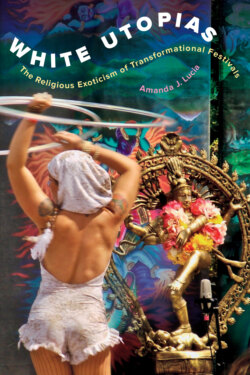Читать книгу White Utopias - Amanda J. Lucia - Страница 18
На сайте Литреса книга снята с продажи.
CHAPTER OUTLINE
ОглавлениеHow are we to evaluate the ways in which the religious exoticism inherent in spirituality is simultaneously a genuine engagement with alterity, a radically transformative method, and an often exploitative form of cultural appropriation? To this, I answer that it is a complex both/and situation. There is no easy answer here. White Utopias grounds this research question sociologically by problematizing religious exoticism and white claims of authority over nonwhite cultural and religious forms juxtaposed against participants’ very real experiences of transformation and spiritual evolution resulting from inspirational engagements with alterity. Chapter 1 charts how religious exoticism draws from Indic religious practices and ideas and Indigenous religions, based in problematic imagined and historical divisions between self and other, modern and primitive, civilized and savage. Chapter 2 focuses explicitly on contemporary yoga, demonstrating how the dominant majority of white yoga teachers parse questions of authenticity. In so doing, I invite readers into a microscopic view of the strategies of building authority in the context of cultural appropriation.
At the midway point of the book, the narrative pivots on a particularly salient comment an informant made during our interview at Lightning in a Bottle in 2015. When I asked Niko, an African American DJ, a general question about his impressions of the festival crowd, he immediately began speaking about race. He viewed the religious exoticism of the largely white population as a first step in the gradual evolutionary journey of white people. Many festival participants also believe they are participating in human evolution and spiritual awakening, but Niko’s comment suggested that white explorations into alterity can puncture white hegemony and even initiate a politics of friendship based in the recognition of shared humanity.
The second half of the book explores this potential evolution through accounts of personal transformation occurring in transformational festivals. Chapter 3 focuses on the intentional denaturalization of the conventional self through the adoption of ascetical practices. Chapter 4 focuses on unexpected self-transformations catalyzed by encounters with wonder in mystical experiences. Chapter 5 investigates the most common theme that was iterated time and again by my interlocutors across these fields: the expression of affective feelings of freedom. This chapter reveals how these feelings of freedom are not only expressions of release from everyday systems of bondage but are also fostered through empathic human connection generated by the festival. In conclusion, I explain why the commitment to personal transformation generates an ideological commons within festivals while also forming a gated commons that tends to reify ethnic and class boundaries. Ironically, the proclivity toward homogeneity augments affective feelings of freedom and the ubiquitous feeling that participants have “come home.” It also fosters feelings of solidarity and supports the feeling of having found one’s “tribe.” While this may be productive for the largely white population of participants, it also erects boundaries that deter racialized others from participating. In this way, what follows explains why their visions of radical alternative utopias remain, at the present, predominantly White Utopias.
